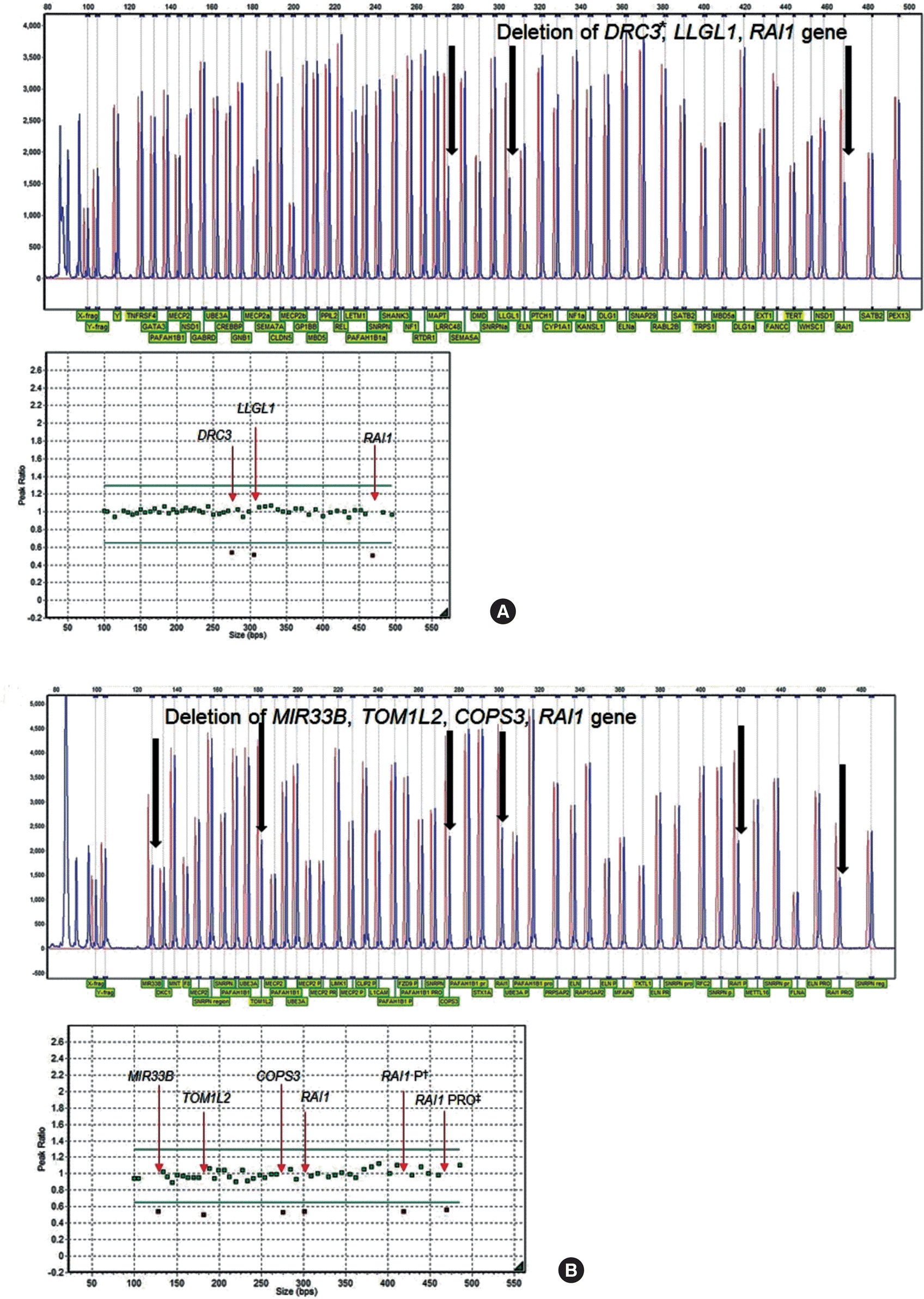REFERENCES
1.Smith AC., McGavran L., Robinson J., Waldstein G., Macfarlane J., Zonona J, et al. Interstitial deletion of (17)(p11.2p11.2) in nine patients. Am J Med Genet. 1986. 24:393–414.

2.Seranski P., Hoff C., Radelof U., Hennig S., Reinhardt R., Schwartz CE, et al. RAI1 is a novel polyglutamine encoding gene that is deleted in Smith-Magenis syndrome patients. Gene. 2001. 270:69–76.

3.Greenberg F., Guzzetta V., Montes de Oca-Luna R., Magenis RE., Smith AC., Richter SF, et al. Molecular analysis of the Smith-Magenis syndrome: a possible contiguous-gene syndrome associated with del(17)(p11.2). Am J Hum Genet. 1991. 49:1207–18.
4.Acquaviva F., Sana ME., Della Monica M., Pinelli M., Postorivo D., Fontana P, et al. First evidence of Smith-Magenis syndrome in mother and daughter due to a novel RAI mutation. Am J Med Genet A. 2017. 173:231–8.

6.Suk JH., Lee SG., Bae JC., Lee HJ., Kim SH. Two cases of Smith-Magenis syndrome with tetralogy of Fallot confrmed by FISH. Korean J Lab Med. 2005. 25:361–4.
7.Jung SK., Park KH., Shin HK., Eun SH., Eun BL., Yoo KH, et al. Two cases of Smith-Magenis syndrome. Korean J Pediatr. 2009. 52:701–4.

8.Lee CG., Park SJ., Yun JN., Yim SY., Sohn YB. Reciprocal deletion and duplication of 17p11.2-11.2: Korean patients with Smith-Magenis syndrome and Potocki-Lupski syndrome. J Korean Med Sci. 2012. 27:1586–90.

9.Kim SE., Kim G., Suh JS., Lee J. A case of Smith-Magenis syndrome with multiple organ malformations. Neonatal Med. 2017. 24:49–52.

10.Allanson JE., Greenberg F., Smith AC. The face of Smith-Magenis syndrome: a subjective and objective study. J Med Genet. 1999. 36:394–7.
11.Vilboux T., Ciccone C., Blancato JK., Cox GF., Deshpande C., Introne WJ, et al. Molecular analysis of the Retinoic Acid Induced 1 gene (RAI1) in patients with suspected Smith-Magenis syndrome without the 17p11.2 deletion. PLoS One. 2011. 6:e22861.

12.Belligni EF., Biamino E., Molinatto C., Messa J., Pierluigi M., Faravelli F, et al. Subtelomeric FISH analysis in 76 patients with syndromic developmental delay/intellectual disability. Ital J Pediatr. 2009. 35:9.

13.Jehee FS., Takamori JT., Medeiros PF., Pordeus AC., Latini FR., Bertola DR, et al. Using a combination of MLPA kits to detect chromosomal imbalances in patients with multiple congenital anomalies and mental retardation is a valuable choice for developing countries. Eur J Med Genet. 2011. 54:e425–32.

14.Miller DT., Adam MP., Aradhya S., Biesecker LG., Brothman AR., Carter NP, et al. Consensus statement: chromosomal microarray is a frst-tier clinical diagnostic test for individuals with developmental disabilities or congenital anomalies. Am J Hum Genet. 2010. 86:749–64.
Fig. 1.
(A) MLPA analysis (red: control, blue: patient) results reveal heterozygous deletion of DRC3, LLGL1, RAI1 gene on 17p11.2. (B) Confirm test covering more loci reveals heterozygous deletion of COPS3, RAI1, MIR33B, TOM1L2 gene on 17p11.2. Abbreviation: MLPA, Multiplex ligation-dependent probe amplification. ∗The name of the Leucine-rich repeat-containing protein 48 (LRRC48) gene has been changed to DRC3; †,‡RAI1 P and RAI1 PRO are different sets of primers of RAI1 gene. The names are randomly added with P and PRO as the analysis software requires different names with matching primers.





 PDF
PDF ePub
ePub Citation
Citation Print
Print


 XML Download
XML Download